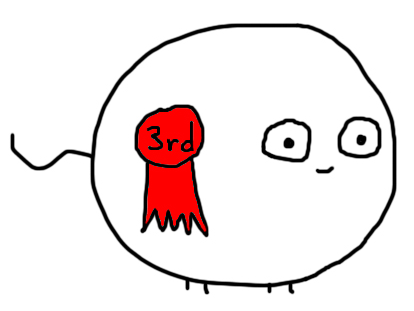
Since 2009, Tao Lin has been compiling a number of entries for an encyclopedia on North American Hamsters. Past entries have included: “Unable to Perceive Neutral Thoughts as Neutral Hamster” and “Non-Eccentric Piano Prodigy Hamster.” In the upcoming months, we’ll be posting more hamsters.
Prize-Winning Hamster
Previously identifiable by the conspicuous growths on the sides of their bodies that resemble (and, tests have shown, literally are) prize ribbons, many Prize-Winning Hamsters have, in the past three years, begun amputating their ribbons in painless procedures utilizing laser technology first developed for use in global warfare. (It should also be noted that it’s not uncommon, even for those who can afford the expensive laser procedure, for Prize-Winning Hamsters to perform DIY surgeries that are often excruciatingly painful and sometimes fatal.) Today an estimated 38% of Prize-Winning Hamsters have de-prized themselves, opting viscerally out of the hierarchy they’ve been born into mysteriously. The other 62% can be identified by prize ribbons ranging mostly from 1st place to 10th, though rankings as low as the mid 40s (and, once, 649th, which is the lowest on record) have been photographed, usually while the subject is running away in shame. It’s been speculated that Prize-Winning Hamsters of each ranking—from 1 to 1000—exist in relatively equal quantity, but that those lower in rank, embarrassed and afraid to be seen, live deep underground, therefore seem rare or nonexistent.
Hunting tips: Prize-Winning Hamsters can be insanely confident (sprinting through public spaces shouting in joy while flailing its entire body, in extreme cases) or severely lacking in self-esteem (crying in small, lightless holes while eating baked goods in scenes of nonhumorous bleakness), depending on the ranking of their prize ribbon. Approach a specimen ranked high enough (9th or better is recommended) that it won’t immediately escape in fear, placing it in a plastic baggie.
Cooking tips: Carefully remove the prize ribbon, which can be used in any situation requiring a prize ribbon of the given ranking. Peel and slice the body like a kiwi, using the skin and its connective fatty tissue to lightly broil the body, which can be sliced or made into a paste. For de-prized hamsters, before doing anything else, excise and discard the scar tissue, which can appear depressing, or at least distracting, and therefore unappetizing, on an otherwise consistently contoured piece of meat.
Tao Lin’s latest book is Taipei.
You have reached your article limit
Sign up for a digital subscription and continue reading all new issues, plus our entire archives, for just $1.50/month.
Already a subscriber? Sign in




